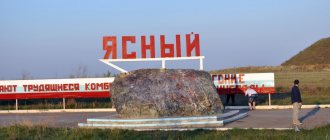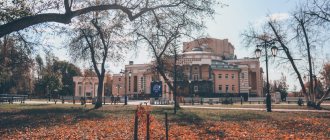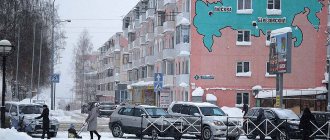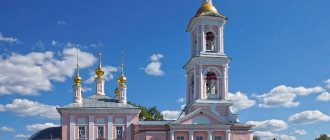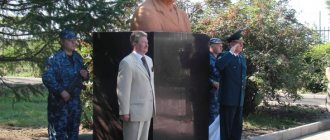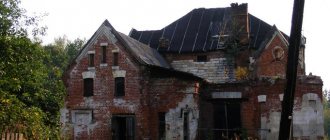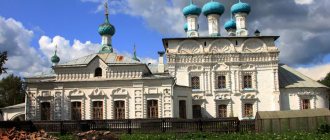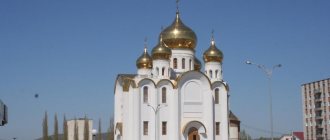Asbest is one of the industrial cities of the Middle Urals. It was built on the edge of a huge quarry in which chrysolite asbestos was mined. The city is located on the right bank of the winding Bolshoi Reft river in the area of Shchuchye Lake. On the satellite map of Asbest you can see that the entire eastern outskirts are occupied by a quarry and dumps, the western by the Bolshoy Reft and Cheremsha rivers, and between them the microdistricts of the “working” town are comfortably located.
From Asbest to Yekaterinburg it is about 80 km. As shown on the map of Asbest with diagrams, the city and other settlements of the Urals are connected by several roads. You can also come to the city, where asbestos has been mined and processed for more than 100 years, by train.
About 66 thousand people live on the territory of the settlement, most of whom work at the main enterprise of the city, UralAsbest. This and other industrial enterprises, as the Asbest map by region allows, are located on the outskirts of the city on the southern and eastern sides.
City `s history
The history of the city begins at the beginning of the 19th century, when the peasants of the Beloyarsk settlement in the swamps near Lake Shchuchye stumbled upon a fibrous mineral - mountain tow , as it was called at that time. Then the place was christened Kudelnoye swamp .
Photo source: Unique Asbestos
However, the official chronicle of asbestos deposits begins in 1884, when UOLE member A.P. Ladyzhensky, near the Kudelny swamp , discovered mineral outcrops, reporting this to the Mining Department . The place was named Bazhenovskoye field - after the Bazhenovo station , located nearby. In post-Soviet times, one of the city streets was named mountain flax
In 1885, the rights to the asbestos deposit were received Ladyzhensky by the Partnership for the Exploitation of Ural Minerals . At the same time, the first asbestos mine appeared, called Voznesensky .
Photo source: Unique Asbestos
And 4 years later, after receiving official permission to develop the deposit from the Mining Department , 11 mines were opened in this area, which became the starting point for the formation of the future city. The newly formed settlement was named after the discovered mineral - the village of Kudelka . 3 sorting factories were also opened. The deposit was developed primarily by manual labor - working conditions, to put it mildly, were difficult.
Gradually, the village's industry developed - in 1896, the first steam engine for pumping water began working at one of the mines, and a year later an asbestos processing factory appeared - the first in Russia . By 1917, 4 private enterprises were operating at the Bazhenovskoye field . They produced about 200 thousand tons of high-quality asbestos, which was sent to Austria , Japan , England and Germany .
Photo source: Unique Asbestos
Uralasbest trust was created , which united the mines of the Bazhenovsky , Nevyanovsky and Rezhevsky districts.
In the early 1930s, the rapid development of the village began - a geological museum appeared, a mining technical school and a secondary school opened, a Palace of Culture with a cinema hall, a hospital complex, as well as a printing house and a furniture factory began operating. And in 1933, the village received city status and a new name - Asbest .
Photo source: Unique Asbestos
In the post-war period, the city continued its development - by the end of the 1960s, Asbest already had a constant bus service, several schools, a hotel and restaurant, a large-format cinema, a sports club, a driving school, and a rest home. In addition, several plants and factories were opened.
Today, Asbest is a typical Central Ural industrial town, not without its own individual features and characteristics.
History[ | ]
Asbestovsky City Council[ | ]
On May 10, 1934, the city of Asbest was classified as a city of regional subordination [4], remaining the administrative center of the Asbestovsky district, which included, in particular, the Izumrudsky council, consisting of the working village of Izumrud and the village named after Malyshev, subordinate to it.
On December 31, 1935, the Asbestovsky district was abolished and its settlements were transferred to the territory of the city of Asbest.
On April 6, 1956, by decision of the regional executive committee No. 157, the village of Ostrovnoye, subordinate to the Asbestovsky City Council, with adjacent forest blocks 1, 2, 8, 9, 15, 16, was transferred to the administrative subordination of the Monetary Council of the city of Berezovsky.
On April 25, 1958, by decision of the regional executive committee No. 259, the village of the Asbestovsky rest home was transferred to the administrative-territorial subordination of the Asbestovsky City Council.
On February 1, 1963, by the Decree of the Presidium of the Supreme Soviet of the RSFSR, the Asbestovsky City Council was subordinated to the Sverdlovsk Regional (Industrial) Council of Workers' Deputies and the City Council transferred the Zarechny [5] and Izumrudsky town councils to subordination.
On April 27, 1963, by decision of the industrial and rural regional executive committees No. 210-176, the villages of the factory named after Asbest were transferred to the subordination of the Zarechny Council of the suburban zone of Asbest from the Beloyarsk Council of the Beloyarsk Rural District. Comintern and Tool Plant, the village of Melzavoda No. 5 of the Zarechny Village Council under the authority of the Beloyarsk City Council, the Kirovsky village of the Zarechny City Council under the Mezen Village Council, the villages of Rezhik and Kamenka from the Yaluninsky Village Council of the Beloyarsk Rural District under the Asbestov City Council.
On August 14, 1964, by decision of the industrial regional executive committee No. 404, the village of Cheremsha was included in the city limits of Asbest and the administrative center of the Izumrudsky village council was supposed to be moved to the village named after Malyshev; on October 23, the decision to move was canceled.
On November 22, 1966, by the Decree of the Presidium of the Supreme Soviet of the RSFSR, the village of department No. 6 of the Bazhenov state farm was renamed the village of Belokamenny.
On November 30, by decision of the regional executive committee No. 937, the settlement during the construction of the Reftinskaya GRES was classified as a working settlement with the name Reftinsky, and the Reftinsky village council was formed.
On May 26, 1967, by decision of the regional executive committee No. 433, the village of Malysheva was given the status of a working village and became the administrative center of the village council, the Izumrudsky village council was renamed Malyshevsky
On March 11, 1971, by decision of the regional executive committee, the Belokamensky village council was formed, which included the villages of Belokamenny (administrative center) and Asbestovskoye rest home.
On December 30, 1976, by decision of the regional executive committee No. 1099, the village of Markovka, which had ceased to exist, was excluded.
On February 9, 1977, by decision of the regional executive committee No. 78, the name of one of the villages of the Malyshevsky village council was clarified: Shameika
Shameisky
variant was encountered ).
On February 23, 1977, by decision of the regional executive committee No. 120, the villages of Novookunevo, Proletarka and Starookunevo were included in the city limits of Asbest.
On March 29, 1978, by decision of the regional executive committee No. 195, the villages of Lesozavod and Novokirpichny of the Malyshevsky village council were included within the boundaries of Izumrud.
On July 24, 1984, by decision of the regional executive committee No. 265, the village of Asbestovsky rest house was excluded from the registration data as it had actually merged with Belokamenny; by decision No. 265-a, a settlement with the proposed name Krasnoarmeysky was registered and transferred to the administrative subordination of the Asbestov City Council; By decision No. 265-b, the railway station under construction for the transportation of goods from the Reftinskaya poultry farm in the city of Asbest was registered as a service facility and given the name “Broiler”.
On March 18, 1985, by Decree of the Presidium of the Supreme Soviet of the RSFSR, the name Krasnoarmeysky was approved for the settlement, fuss
On February 22, 1991, by decision of the regional executive committee No. 89, the Krasnoarmeysky Village Council was formed.
On April 18, 1991, by decision of the regional executive committee No. 204, the city limits of Asbest were established.
Municipalities[ | ]
In 1992, the municipality of the city of Asbest
, from which subsequently in 1995-1996, based on the results of local referendums, the municipalities of
the working village of Malysheva
,
Reftinsky
and
the village of Belokamenny
. On November 10, 1996, municipalities were included in the regional register[6]. The village of Belokamenny represented one of the few independent rural municipalities of a non-district type at that time. On January 1, 1998, the village was restored as part of the municipality of the city of Asbest[7].
From December 31, 2004, as part of the local government reform, the municipal formations of the city of Asbest[8], the working village of Malysheva[9] and the village of Reftinsky[10] were given the status of urban districts, while the working village of Izumrud was classified as part of the municipal formation, the working village of Malysheva to rural settlements[11]. On January 1, 2006, the names were approved: Asbestovsky urban district[12], Malyshevsky urban district[13], Reftinsky urban district[14].
Sights of Asbest
Museum of the Uralasbest plant
Photo source: Asbestos News
The museum's collections contain various minerals and rocks mined in the vicinity of the city - in the Bazhenov deposit . Also here you can see various products made of asbestos and serpentinite. A separate exhibition is dedicated to the history of the Bazhenovskoye field and, accordingly, the city.
In the museum you can learn about the history, awards and work of the plant itself.
Address: st. Lenina, 14
Asbestovsky Historical Museum
Photo source: Asbestos Historical Museum
Here visitors will be told about asbestos itself, for example, about its use in Ancient Greece and Corsica . So it is about the history of the city - about the contribution of city residents to the victory in the Great Patriotic War , about the work of various factories, about the life and culture of asbestos workers in different periods.
The most valuable exhibits are a desk, a gramophone and a cabinet piano from the 19th century, as well as an antique cast bell.
Asbestovsky Historical Museum
Address: Asbest, st. Mira 12 Contacts: +7 (34365) 2-90-51 Website: uole-museum.ru
Memorial Museum N.M. Avvakumova
Photo source: semantic.uraic.ru
Nikolay Avvakumov is one of the most famous graphic artists in the Urals . At one time he worked as an art correspondent, sketching the most important moments and events of the era. most famous works are portraits of the country’s first people, as well as his posters, sketches, and graphic reports dedicated to military operations (during the war years, the artist worked as an artist-correspondent for the Frontovik newspaper as part of the 3rd Shock Army).
However, a separate part of the life of the graphic reporter is connected with the city of Asbest , in connection with which a museum was created. The memorial museum was opened in 1976 in the Palace of Pioneers . Here you can get acquainted with the life and works of Nikolai Mikhailovich .
Address: st. Uralskaya, 75
Monument to A.P. Ladyzhensky
Photo source: situr.rf
Ladyzhensky is the discoverer of the Bazhenov deposit and, in fact, the person without whose discovery Asbestos would not have appeared. Therefore, it is only logical that a monument was erected in his memory. In addition, Alexey Pavlovich is one of the first participants in the Ural Society of Natural History Lovers . The monument is located opposite the Palace of Pioneers and is a bust of the discoverer on a pedestal.
GPS coordinates: 57.013474, 61.469913
Victory Alley
Victory Alley is one of the central alleys of the city, where people come to relax and stroll among the trees. The main city monuments related to the wars are concentrated here - the monument to internationalist soldiers ; a monument to the soldiers who died in the North Caucasus (or a monument to the soldiers of the Urals), as well as the largest monument in the city - the Victory Memorial , erected for the 20th anniversary of the victory in the Great Patriotic War .
Photo source: situr.rf
Also on the Alley is the most famous bench of the city - the Bench of Reconciliation , which was installed at his own expense by one of the residents of Asbest . The right and left sides of the bench are at an angle, so people sitting on it gradually slide towards each other. The bench is located not far from the city court - so that people going to court have the opportunity to reconcile on their own (at least think about it).
Photo source: newsland.com
GPS coordinates: 57.014240, 61.462013
Sculptures at the House of Culture
The sculptures at the entrance to the House of Culture depict two muses and appeared here in the mid-50s of the 20th century, immediately after the completion of the construction of the House of Culture . For a long time, the author of the muses remained a mystery - it was assumed that they were made by Ernst Neizvestny , but there was no official confirmation.
The information was confirmed only in 2013, when a local historian contacted Neizvestny personally. The latter immediately recognized his muses. It is believed that the sculptures are Neizvestny’s .
Let us remind you that in Yekaterinburg there is a museum of Ernst the Unknown .
Address: st. Osipenko, 32
Notes[ | ]
- from the point of view of the administrative-territorial structure
- Population of the Russian Federation by municipalities as of January 1, 2022 (Russian). Date accessed: October 17, 2022. Archived October 17, 2022.
- Total
- ↑ 12
Administrative-territorial structure of the Sverdlovsk region. Archive - Subsequently, the Zarechny Council was restored as part of the Beloyarsk region, there is no information about the specific date of this change
- Decree of the Governor of the Sverdlovsk Region of November 10, 1996 No. 409 “On approval of the regional register of municipalities”
- On the inclusion of the village of Belokamenny in the municipal formation “city. Asbestos”, Decree of the Government of the Sverdlovsk Region of December 17, 1997 No. 1071-p
- On establishing the boundaries of the municipal formation of the city of Asbest and granting it the status of an urban district (as amended on July 12, 2007), Law of the Sverdlovsk Region of July 21, 2004 No. 33-OZ (unspecified)
. docs.cntd.ru. Access date: April 24, 2022. - On establishing the boundaries of the municipal formation of the working settlement of Malysheva and granting it the status of an urban district (as amended on July 12, 2007), Law of the Sverdlovsk Region of October 12, 2004 No. 98-OZ (undefined)
. docs.cntd.ru. Access date: April 24, 2022. - On establishing the boundaries of the municipal formation of the village of Reftinsky and granting it the status of an urban district (as amended on July 12, 2007), Law of the Sverdlovsk Region of July 21, 2004 No. 45-OZ (undefined)
. docs.cntd.ru. Access date: April 24, 2022. - On the classification of the working village of Izumrud, located within the administrative boundaries of the city of Asbest, to the category of rural settlements as a type of village, Law of the Sverdlovsk Region of October 12, 2004 No. 107-OZ
- Charter of the Asbestovsky urban district
- Charter of Malyshevsky urban district
- Charter of the Reftinsky urban district
- On approval of the list of administrative-territorial units and settlements of the Sverdlovsk region in a new edition and recognition of paragraph 1 of Order No. 8-P dated January 11, 2016 as no longer in force, Order No. 28-P dated January 23, 2017
- Order of construction and infrastructure development of the Sverdlovsk region dated January 23, 2017 No. 28-P, original
- On measures to implement the Law of the Sverdlovsk Region “On the administrative-territorial structure of the Sverdlovsk Region”, Law of the Sverdlovsk Region dated April 13, 2022 No. 35-OZ
- ↑ 123
at the time of abolition: as part of the municipal formation, the working village of Malysheva - names of municipalities before January 1, 2006: the city of Asbest, the working village of Malysheva, the village of Reftinsky, statuses: until December 31, 2004, city and settlements (working villages), from December 31, 2004, urban districts
- ↑ 123
The permanent population of the Russian Federation by municipalities as of January 1, 2022 (Russian). Retrieved April 27, 2022. Archived May 2, 2022. - ↑ 1 2 3 4 5
Number and distribution of the population of the Sverdlovsk region (Russian) (inaccessible link).
All-Russian Population Census 2010
. Department of the Federal State Statistics Service for the Sverdlovsk Region and Kurgan Region. Access date: April 16, 2022. Archived September 28, 2013. - On the classification of the working village of Izumrud, located within the administrative boundaries of the city of Asbest, to the category of rural settlements as a type of village, Law of the Sverdlovsk Region of October 12, 2004 No. 107-OZ (unspecified)
. docs.cntd.ru. Access date: April 22, 2022. - ↑ 123
Sverdlovsk region. Administrative division as of January 1, 1987 - Urban-type settlements subordinate to the Administration of the city of Asbest/
- Rural settlements subordinate to the Administration of the Republic of Malyshev
- On the abolition of individual settlements in the Sverdlovsk region, Law of the Sverdlovsk region of November 28, 2001 No. 64-OZ (undefined)
. docs.cntd.ru. Date accessed: March 19, 2022. - On the abolition of the village of Ilyinsky, located within the administrative boundaries of the city of Asbest, Law of the Sverdlovsk Region of November 22, 2004 No. 179-OZ (unspecified)
. docs.cntd.ru. Access date: April 24, 2022.
Abandoned Asbestos
In addition to the main attractions, there are quite a lot of interesting abandoned objects Asbest
Photo source: Unique Asbestos
One of the most interesting is the cemetery of agricultural machinery in the village of Krasnoarmeyskoye . In total there are about 30 pieces of equipment - all kinds of trailers, tractors, buses, combines and others.
Photo source: Unique Asbestos
Another abandoned landmark of the city is a 5-story water tower (height 35 meters). Initially, the tower was the tallest building in the city, but with modern development its height no longer seems so outstanding. The tower is installed in the historical center of Asbest - today it is literally the edge of the quarry.
Water Tower / Photo Source: Unique Asbestos
the USA in the early 2000s - for Russia such architecture is unique.
Abandoned greenhouse on Reftinsky / Photo source: Unique Asbest
greenhouse complex on Reftinsky has become quite a popular place . There are 14 dilapidated greenhouses on the territory, connected by a common corridor. In addition, a 2-story administrative building, a utility building, 3 security booths and several utility sheds have been preserved here. At first glance, there is nothing interesting in the greenhouses, but they make for surprisingly atmospheric photographs.
Asbestos Quarries
Kvartalny Quarry / Photo source: Unique Asbest
The Asbestov quarry is probably the most famous landmark of the city. If you open any electronic map, you will immediately see that the quarry is almost larger than the city itself. It is also interesting that it is located in the very center (geographical) of Asbest , and not on the outskirts, as is often the case. The quarry stretches 11 kilometers long, 2.5 kilometers wide and 350 meters deep.
Aul quarry / Photo source: Unique Asbestos
Here we described the Asbestos quarry in detail.
Malyshevsky dump / Photo source: Unique Asbest
The surroundings of Asbest are also rich in various quarries - Krasnobolotinsky mine , Aulsky quarry , Kvartalny quarry , Krasnoarmeysky mine and others.
